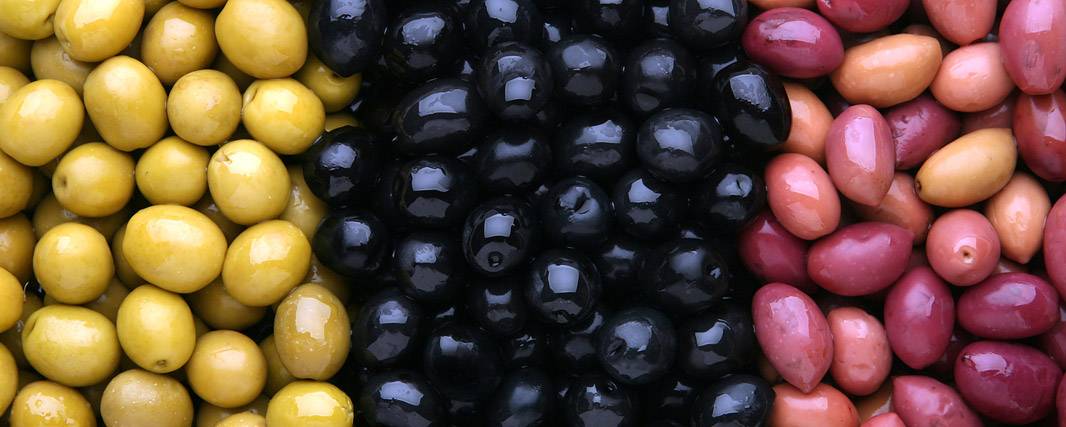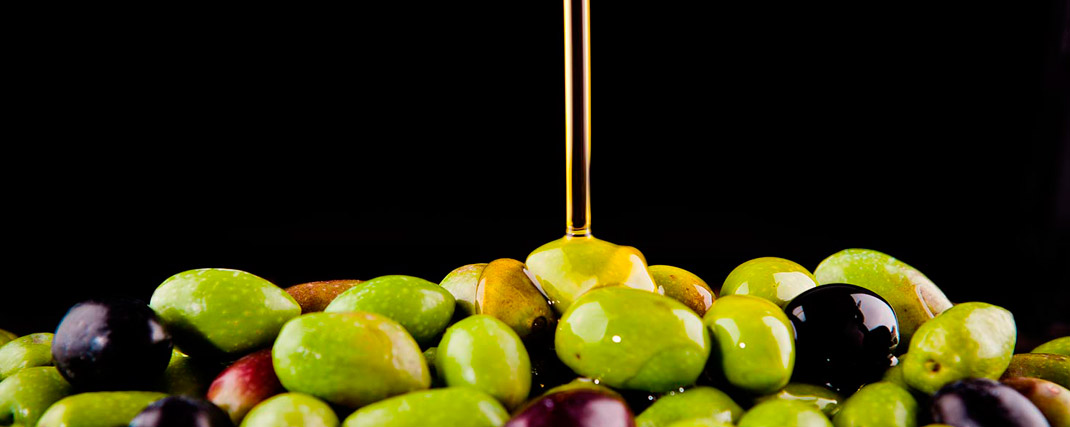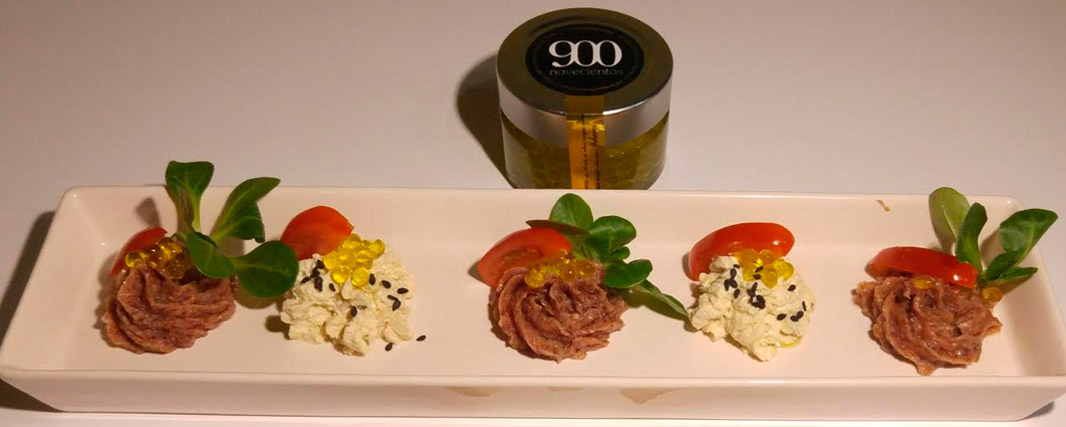
According to data from a large number of studies, more than two hundred and sixty varieties of olive are grown in Spain. Of those, most are used in the production of olive oil, whilst others are more suitable as table olives. Even though the variety of olives is wide, they are by no means equally widespread. Around twenty types are widely grown. Only four of these account for sixty per cent of olive growth, and one of those, the Picual, which is very typical of Jaén, accounts for about half of Spanish olive oil.
In each area, different olives are grown, suited to the climate and the soil and with distinctive flavours and aromas. This means that the different olives grown produce oils with personalities specific to their regions.
This range of olives makes it possible to produce single variety or blended oils. Single variety oils are those made from only one type of olive: for example, extra virgin olive oil from the Picual type. In a single variety olive oil, the taste characteristics identified with that variety dominate. In blended olive oils, two or more olive types are combined in precise proportions, in order to balance the flavours in the oil which results. This practice enhances the consumer’s taste experience. This is true of our extra virgin olive oil 900 Top, for which we select, in ideal proportions, oil from Picual, Picudo and Hojiblanca olives, whose characteristics will be explained below.
The considerable nutritional benefits of olive oil are now recognised world-wide; and its excellent culinary quality is so indispensible to the Meditteranean Diet that the idea of the Meditteranean Diet would mean nothing without it. In extra virgin olive oil we meet its highest expression of quality, and therefore aroma and taste. Such is its reputation that these days, a good olive oil has become one of the gourmet palate’s most cherished gifts. Its use in the kitchen can improve even the most exquisite dishes.
The fact is that we possess a rich culinary heritage that offers great health benefits; and, moreover, which presents a landscape unique in the world, only visible here, in Andalucía, and especially in Jaén, where you can contemplate endless olive groves for as far as the eye can see. Next, we will describe the olive varieties most commonly grown in Spain, accounting for the greater part of our olive oil production.
See more at: https://www.aceitenovecientos.com/variedades-de-aceitunas/#sthash.XBP9JG2m.dpuf
PICUAL
Es la variedad más producida en el mundo, representa un 20% a nivel mundial y un 50% en España, dónde las zonas de mayor producción son Jaén predominantemente y Córdoba, Granada, Málaga, Ciudad Real y Badajoz. Sus características son de un aceite con una gran estabilidad y personalidad, fuerza, verde hierba, frutosidad, un amargor intenso y claros tonos picantes. Se caracteriza por su alta productividad y por adaptarse fácilmente a las condiciones del clima y suelo. Sus atributos son altamente peculiares y la hacen una de las variedades con más propiedades saludables. En otra ocasión nos centraremos en esta variedad. El vigor del árbol es bueno, con copas vigorosas y gran desarrollo foliáceo. La hoja es alargada y el fruto elipsoida.
See more at https://www.aceitenovecientos.com/variedades-de-aceitunas/#sthash.LKp7QeDd.dpuf:
PICUAL
This is the most grown variety in the world, representing twenty per cent of world growth and fifty per cent of Spanish growth. In Spain, the main production areas are Jaén – predominantly – and also Córdoba, Granada, Málaga, Ciudad Real y Badajoz. Its oil has great equilibrium and character, strongly flavoured with green herb and fruit notes, yet also bitter and with clear spicy tones. Picual gives high crop levels and adapts easily to climate and ground conditions. Its attributes are highly unusual and make it one of the most health-giving varieties of all. In a later post we will focus on Picual. The tree is strong, with a vigorous crown and leaf development. The leaf is long and the fruit oval.
See more at https://www.aceitenovecientos.com/variedades-de-aceitunas/#sthash.LKp7QeDd.dpuf:
PICUDO
Con unas características peculiares que hacen que su fruto dé lugar a un aceite afrutado con regusto de almendra, sabor fresco, con toque a manzana y olor dulce. Proporciona aceites muy equilibrados con gran dulzura. Su aceite es delicado ante la oxidación. Es una de las variedades más andaluzas siendo la zona de mayor producción en España, Córdoba, protegida con DO Baena y Priego de Córdoba. No confundir con la variedad picual por el parecido del nombre, ya que, sus cualidades son distintas.
See more at: https://www.aceitenovecientos.com/variedades-de-aceitunas/#sthash.LKp7QeDd.dpuf
PICUDO
Picudo olives have characteristics that give fruity tones to their oil. It has a fresh flavour that has a touch of apple, a sweet aroma, and an almond aftertaste. Picudo olives give a very well balanced, highly sweet oil. Their oil is sensitive to oxidation. Picudo is one of the most Andalucían varieties, its main Spanish production zone, Córdoba,being protected by the denominaciones de origen (official origin marks) of Baena and Priego de Cordoba. Though their names are similar, Picual and Picudo must not be confused, because their qualities are distinct.
See more at: https://www.aceitenovecientos.com/variedades-de-aceitunas/#sthash.LKp7QeDd.dpuf
ARBEQUINA
Se trata de una de las variedades con mayor porcentaje de extracción de aceite. Sus características principales son un aceite muy fluido, verde con reflejos amarillentos, de aroma fresco, afrutado, con toques de manzana y almendra fresca, suave y dulce sin apenas amargor y picor. En España se produce en Cataluña y Aragón, principalmente.
La planta es de poco vigor, con brotes largos y poco ramificados. La hoja es acanalada y ensanchada por el ápice, mientras que el fruto es pequeño, ovalado y casi simétrico.
See more at: https://www.aceitenovecientos.com/variedades-de-aceitunas/#sthash.LKp7QeDd.dpuf
ARBEQUINA
This is one of the olive varieities that accounts for a high proportion of oil production. Its principal characteristics are a very fluid oil, green with yellowish lights, with a fresh aroma, fruity, with hints of fresh apple and almond, smooth and sweet with only slight bitterness and spiciness. The principal Spanish production zones are Cataluña and Aragón.
The tree is a less vigorous one, with long shoots and few branches. Its leaf is grooved and widens at the tip, whilst the fruit is small, oval and nearly symmetrical.
See more at: https://www.aceitenovecientos.com/variedades-de-aceitunas/#sthash.LKp7QeDd.dpuf
HOJIBLANCA
Posee la cualidad de tener doble aptitud, para aceite y para aceituna de mesa. Principalmente produce un aceite bastante afrutado, verde hierba intenso, con aromas de frutas maduras y recuerdos de aguacate, dulce, ligero picante en garganta y regusto final almendrado. La zona de producción en España es en Málaga, Sevilla y Córdoba.
El vigor del árbol es de medio a bueno con copa de densidad media. La hoja es alargada y parcialmente acanalada y el fruto es de tamaño grande y oblongo.
See more at: https://www.aceitenovecientos.com/variedades-de-aceitunas/#sthash.LKp7QeDd.dpuf
HOJIBLANCA
This olive has a double use, for olive oil or as a table olive. Its principal use is for a quite fruity oil, with intense green herb notes, aromas of ripe fruit and hints of avocado, sweet, lightly spicy on the palate and with a final almond aftertaste. The Spanish production zones are Málaga, Sevilla and Córdoba.
Tree strength is medium to good with medium crown density. The leaf is long, and partly grooved, and the fruit is large and oblong.
See more at: https://www.aceitenovecientos.com/variedades-de-aceitunas/#sthash.LKp7QeDd.dpuf
EMPELTRE
Aceituna típicamente cultivada en el Bajo Aragón. Con ella se elaboran aceites de color entre amarillo paja y oro viejo. Tiene aromas de frutas, sobre todo de manzana y un sabor suave y dulce. Además de en Aragón se utiliza también en Rioja, Navarra y algo de Cataluña.
Árbol de gran vigor con ramos erguidos y hojas anchas y algo alabeadas. El fruto es asimétrico y alargado.
See more at: https://www.aceitenovecientos.com/variedades-de-aceitunas/#sthash.LKp7QeDd.dpuf
EMPELTRE
This olive is typical of lower Aragón. It is used to create olive oils of a colour that is between straw yellow and old gold. It has fruit aromas, above all apple, and a smooth, sweet flavour. As well as in Aragón it is also used in Rioja, Navarra and parts of Cataluña. The tree is very vigorous, with upright branches and broad leaves, some of which twist. The fruit is asymmetrical and long.
See more at: https://www.aceitenovecientos.com/variedades-de-aceitunas/#sthash.LKp7QeDd.dpuf
FARGA
Esta variedad proveniente del sur de Tarragona y norte de Castellón y algo en la provincia de Teruel, tiene un color verde dorado, con aroma afrutado, sabor muy agradable por ser suave y dulce, con notas amargas y picantes.
Sus árboles son de gran vigor, porte abierto, con ramas rectas algo péndulas. Presentan una copa frondosa, donde los frutos se encuentran a veces aislados. Dichos frutos son de tamaño pequeño a mediano y cuelgan de un largo pedúnculo. Su maduración es temprana y presentan una gran resistencia al desprendimiento.
See more at: https://www.aceitenovecientos.com/variedades-de-aceitunas/#sthash.LKp7QeDd.dpuf
FARGA
This variety comes from the south of Tarragona, the north of Castellón and parts of Teruel province. It has a golden green colour, with a fruity aroma, and a very agreeable smooth and sweet taste with bitter and spicy notes. The trees are very vigorous, with an open appearance and straight, sometimes weeping branches. They show a luxuriant crown, in which the fruits sometimes seem isolated. These fruits are small to medium in size and hang from a long stem. They mature early and are very resistant to falling.
See more at: https://www.aceitenovecientos.com/variedades-de-aceitunas/#sthash.LKp7QeDd.dpuf
CORNICABRA
Su agradable aceite tiene un color amarillo verdoso a oro, aromas frescos a fruta con sabor a frutas maduras, entre las que destaca la manzana, ligeramente amargo y picante. Su zona de producción en España es en Toledo y Ciudad Real dominando toda la zona central. Constituye la segunda variedad española en cuanto a superficie cultivada.
El árbol es de vigor medio con ramos de mediana longitud y con escasa formación de brotes. La hoja es larga y lanceolada y el fruto es largo curvo, asimétrico y con el vientre en forma de cuerno.
See more at: https://www.aceitenovecientos.com/variedades-de-aceitunas/#sthash.D95MUMou.dpuf
CORNICABRA
The pleasant oil of the Cornicabra olive has a yellowish-green to gold colour, fresh fruit aromas and ripe fruit flavours, especially of apple, and is lightly bitter and spicy. Its Spanish production zone of Toledo and Cuidad Real dominates olive production in central Spain. In terms of ground covered, it is the second most cultivated Spanish olive variety.
The tree is of medium vigour with medium length branches and scarce shoots. The leaf is long and pointed and the fruit is large, curved, asymmetrical and
horn-shaped.
See more at: https://www.aceitenovecientos.com/variedades-de-aceitunas/#sthash.D95MUMou.dpuf
ALFAFARENCA
Proporciona unos aceites muy aromáticos con frutado verde ligeramente amargo. Se trata de aceites muy estables por su alto contenido en ácido oleico y polifenoles y con importantes propiedades antioxidantes.
See more at: https://www.aceitenovecientos.com/variedades-de-aceitunas/#sthash.D95MUMou.dpuf
ALFAFARENCA
This olive gives very aromatic oils, with slightly bitter green fruit flavours. These oils are very stable, because of their high oleic acid and polyphenol content, and have important anti-oxidant properties.
See more at: https://www.aceitenovecientos.com/variedades-de-aceitunas/#sthash.D95MUMou.dpuf
LECHÍN
Entre sus principales características están su color blanquecino (de ahí su nombre) y el aceite tiene una amargura media, con un sabor a almendra verde. Su aceite es relativamente inestable. En España se distribuye por Sevilla, Córdoba, Cádiz, Málaga y Huelva.
El árbol es vigoroso con ramas cortas y copa espesa. La hoja es corta y casi plana y el fruto es elipsoidal y algo abombado por el dorso.
See more at: https://www.aceitenovecientos.com/variedades-de-aceitunas/#sthash.D95MUMou.dpuf
LECHÍN
Among this olive’s characteristic properties are its whitish colour (hence its name) and its oil has a medium bitterness, with a green almond flavour. The oil is relatively less stable. In Spain it is found in Sevilla, Córdoba, Cádiz, Málaga and Huelva.
The tree is vigorous with short branches and a thick crown. The leaf is short, almost flat, and the fruit is elliptical and somewhat bulgy at the back.
See more at: https://www.aceitenovecientos.com/variedades-de-aceitunas/#sthash.D95MUMou.dpuf
VERDIAL DE BADAJOZ
Esta variedad típicamente extremeña (se cultiva tanto en Badajoz como en Cáceres) es una de las muchas verdiales que encontramos repartidas por la geografía del olivar español y que se diferencian por la referencia a la zona de cultivo. La de Badajoz es una verdial que nos ofrece unos vírgenes de frutado medio-alto. Destaca en boca por los tonos a almendras y frutas maduras. Presenta un amargo ligero, con un picor más marcado. Estamos ante un aceite ligeramente dulce. El árbol es resistente a la sequía y se emplea como patrón. El fruto es de gran tamaño y es de doble aptitud.
See more at: https://www.aceitenovecientos.com/variedades-de-aceitunas/#sthash.D95MUMou.dpuf
VERDIAL DE BADAJOZ
This typical olive of Extremadura, grown as much in Cáceres as in Badajoz, is one of the many Verdial olives that we find in Spain’s olive landscape and which are differentiated according to the cultivation zone. The Verdial de Badajoz offers
virgin olive oils of medium to high fruitiness. The tastes of almonds and ripe fruits predominate. There is a light bitterness, with a more pronounced spiciness. These are slightly sweet oils. The tree is drought-resistant and is used as the chief one in the area. The fruit is large in size and has ‘double use’.
See more at: https://www.aceitenovecientos.com/variedades-de-aceitunas/#sthash.D95MUMou.dpuf
MANZANILLA O CACEREÑA
Es una de las variedades de aceituna que son aptas tanto para mesa como para producir aceite de oliva. Se trata de un aceite que tiene bastante cuerpo, con aroma a hierba, y frutos maduros, su sabor es fuerte, con notas amargas y picantes. Se cultiva en la provincia de Sevilla, principalmente en las proximidades de la capital.
El árbol es de poco vigor y de copa poco densa. Las hojas son cortas y gruesas y el fruto es ovalado. Se emplea fundamentalmente como aceituna para aderezo
See more at: https://www.aceitenovecientos.com/variedades-de-aceitunas/#sthash.D95MUMou.dpuf
MANZANILLA or CACEREÑA
This is another one of the varieties that are just as suitable for the table or for oil production. It is quite a full-bodied olive, with herbal and ripe fruit aromas; the flavour is strong ,with bitter and spicy notes. It is grown in Sevilla, principally around the city of Sevilla.
The tree is relatively less vigorous and with a less dense crown. The leaves are short and thick and the fruit is oval. These olives are mostly used as dressing or seasoning.
See more at: https://www.aceitenovecientos.com/variedades-de-aceitunas/#sthash.D95MUMou.dpuf
BLANQUETA
La blanqueta produce unos aceites de tono verde hoja y muy aromáticos, afrutado con notas de tomate verde. Su sabor es picante y tiene un suave amargor. Tiene elevado índice de ácido linoleico. Se cultiva en Alicante y Sur de Valencia.
El árbol es de poco vigor con ramos cortos, la hoja es corta y lanceolada y el fruto es algo ovalado y ligeramente asimétrico.
See more at: https://www.aceitenovecientos.com/variedades-de-aceitunas/#sthash.D95MUMou.dpuf
BLANQUETA
Blanqueta olives produce very aromatic, green-leaf-toned oils, flavoured with green tomato notes. Their taste is spicy and has a smooth bitterness. They have a high linoleic acid content. They are grown in Alicante and in the south of Valencia.
The tree is less vigorous with short branches, the leaf is short and pointed and the fruit somewhat oval and slightly asymmetrical.
See more at: https://www.aceitenovecientos.com/variedades-de-aceitunas/#sthash.D95MUMou.dpuf
BIBLIOGRAFÍA: HUMANES, J.; CIVANTOS, M. 1992. Producción de aceite de oliva de calidad. Influencia del cultivo. Consejería de Agricultura y Pesca. Junta de Andalucía.
Otras fuentes: Agencia del Aceite de Oliva del Ministerio de Medio Ambiente Rural y Marino
See more at: https://www.aceitenovecientos.com/variedades-de-aceitunas/#sthash.D95MUMou.dpuf
BIBLIOGRAPHY: HUMANES, J.; CIVANTOS, M. 1992. Producción de aceite de oliva de calidad. Influencia del cultivo. Consejería de Agricultura y Pesca. Junta de Andalucía.
Other sources:Agencia del Aceite de Oliva del Ministerio de Medio Ambiente Rural y Marino
See more at: https://www.aceitenovecientos.com/variedades-de-aceitunas/#sthash.D95MUMou.dpuf



